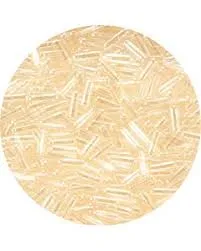
10월 . 13, 2024 14:24 Back to list
chemical structure of hpmc
The Chemical Structure of Hydroxypropyl Methylcellulose (HPMC)
Hydroxypropyl Methylcellulose (HPMC) is a versatile cellulose ether that has garnered significant attention in various fields, including pharmaceuticals, food processing, and cosmetics. This compound is a derived form of cellulose, the most abundant organic polymer on Earth, obtained from the natural plant material cellulose through a series of chemical modifications. The unique chemical structure of HPMC lends it a range of functional properties, making it a valuable ingredient in numerous applications.
The Chemical Structure of Hydroxypropyl Methylcellulose (HPMC)
The degree of substitution is crucial as it determines the solubility, viscosity, and other characteristics of HPMC in solution. Typically, HPMC has a methyl substitution level between 19% and 30% and a hydroxypropyl substitution of around 5% to 16%. These modifications significantly enhance the solubility of HPMC in both cold and hot water, a feature that is essential for its applications in aqueous environments.
chemical structure of hpmc

The molecular structure of HPMC results in a highly hydrophilic polymer with a complex, tangled configuration in solution. As a result, it exhibits significant thickening and gelling properties, making it an ideal thickening agent and stabilizer in various formulations. In the pharmaceutical sector, HPMC is extensively used in the production of controlled-release drug formulations due to its gel-forming capability when in contact with water, thus allowing for a gradual release of active ingredients over time.
Moreover, HPMC plays a vital role in the field of food science as a food additive. Its ability to hold moisture and create a desirable texture has made it a common ingredient in gluten-free products, providing elasticity and a palatable mouthfeel. Furthermore, in cosmetic formulations, HPMC acts as a binder, film-forming agent, and emulsifier, contributing to the stability and effectiveness of products like lotions, creams, and gels.
Interestingly, the properties of HPMC can be tailored further through different processing techniques, such as varying the temperature, pH, and concentration. This ability to modify its characteristics makes HPMC a highly adaptable ingredient suitable for specific formulation requirements.
In conclusion, the chemical structure of Hydroxypropyl Methylcellulose (HPMC) is a fine example of the interplay between natural polymers and synthetic chemistry. The strategic modification of cellulose leads to a compound that is not only multifunctional but also indispensable across various industries. As research and technology continue to develop, the applications and enhancements of HPMC will likely expand, further emphasizing its importance in modern formulations. Its unique properties, stemming from its distinctive chemical structure, ensure that HPMC will remain a subject of interest in both scientific research and industrial use.
-
The Widespread Application of Redispersible Powder in Construction and Building Materials
NewsMay.16,2025
-
The Widespread Application of Hpmc in the Detergent Industry
NewsMay.16,2025
-
The Main Applications of Hydroxyethyl Cellulose in Paints and Coatings
NewsMay.16,2025
-
Mortar Bonding Agent: the Key to Enhancing the Adhesion Between New and Old Mortar Layers and Between Mortar and Different Substrates
NewsMay.16,2025
-
HPMC: Application as a thickener and excipient
NewsMay.16,2025
-
Hec Cellulose Cellulose: Multi functional dispersants and high-efficiency thickeners
NewsMay.16,2025







